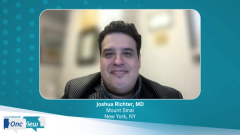
Clinical Pearls and Unmet Needs in R/R Multiple Myeloma
Joshua Richter, MD, offers advice to community oncologists and discusses unmet needs in the treatment of patients with relapsed/refractory MM.
Episodes in this series

Transcript:
Joshua Richter, MD: There are a couple of clinical pearls I would like to share. One is, we recognize that triplet [therapies] are better than doublets, and that the average patient with myeloma in the community may be older or frailer, and there may be somewhat of a reticence to using triplet-based therapies. In general, I would always recommend a dose-adjusted triplet, as opposed to a full-dose doublet, to get more mechanisms of action to kill more myeloma. For example, instead of using lenalidomide and dexamethasone at a dose of 25 mg of lenalidomide and 40 mg of dexamethasone, you could use a regimen like daratumumab, lenalidomide, dexamethasone, and dose reduce the REVLIMID [lenalidomide] from 25 mg to 10 or 15 mg, and the dexamethasone down to 12 or 20 mg, and you get multiple mechanisms of cell kill.
The other thing is that there’s essentially no drug that’s prohibited for most patients with myeloma. Yes, there are always going to be some absolute contraindications, but with appropriate prophylactic medications and dose adjustments, almost every drug can be given to almost every patient with myeloma. It may not be your first choice, it may be your third or fifth choice.
For example, carfilzomib is a drug for which I hear a lot of community physicians saying, “I’m concerned about using this because of cardiac toxicity.” Remembering that the majority of the cardiac toxicity was reversible, it is still a relatively uncommon thing; in many studies it ranges between 2% and 4%. We can give patients prophylaxis, we can identify patients, and we can dose adjust to give carfilzomib combinations, selinexor combinations, and even bispecific antibodies. Embrace the fact that dose adjustments are key. Even upfront dose adjustments may be necessary for certain drugs in certain patients. And try to give triplets more than doublets if possible.
There are a few unmet needs. Some of them are broad based and some are very specific. In general, we still have an unmet need for patients with heavily refractory disease, so patients who are not just penta-refractory, but refractory to BCMA therapies as well. What happens when patients progress beyond CAR [chimeric antigen receptor] T-cell therapy? We don’t have answers. Some of our older patients are still underperforming. Patients of African American and Latino subgroups are not necessarily performing as well as patients of Caucasian subgroups, so we need to do better there.
A more specific one is what to do in the third or fourth line, because many of our great therapies are for patients with 4-plus lines of therapy. At the moment, CAR T-cell therapy and bispecific antibodies are for patients who have had at least 4 lines of prior therapy, and we’re having difficulty with what to do in that fourth line to get them to the fourth-line plus, to bridge them there. We’re trying to figure out what to do to bridge patients to get some of these new therapies, like CAR T cell and bispecific antibodies, especially in a setting where availability of slots for these is somewhat limited.
I hope this has been extremely informative. Thank you to our audience for watching this contemporary CancerNetwork® OncView® program. We hope you found this to be valuable for your clinical practice.
Transcript edited for clarity.
Newsletter
Stay up to date on recent advances in the multidisciplinary approach to cancer.



















































































